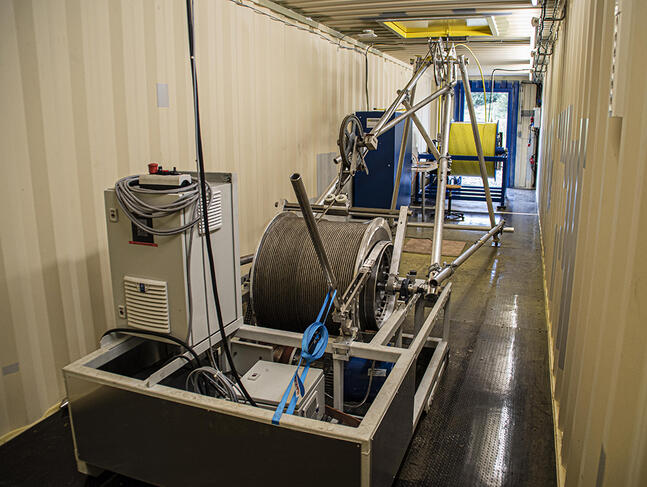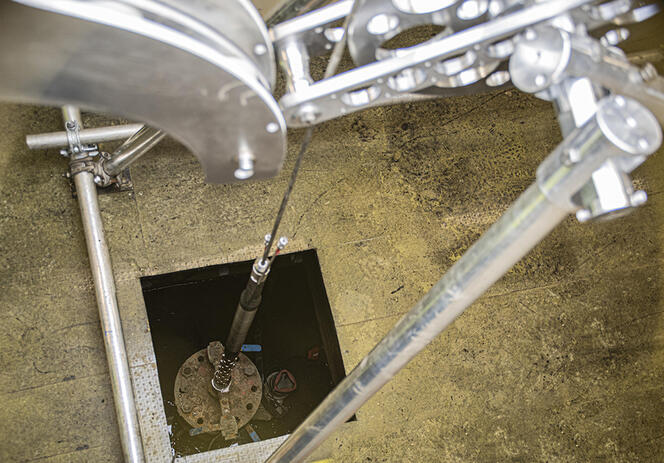
Posted on 03/22/2025 7:41:34 PM PDT by Red Badger
This discovery positions France to lead the charge in hydrogen production, boosting local economies.

Hydrogen renewable energy tanks in facility on the woods. (Representational image)
iStock
Scientists in France have made a groundbreaking discovery that could transform clean energy production. Beneath the soil of Folschviller, in the Moselle region, researchers have uncovered an astonishing 46 million tons of natural hydrogen.
This unexpected find has the potential to reshape global energy strategies by providing a new source of carbon-free fuel.
The discovery was made by scientists from the GeoRessources laboratory and the CNRS while they were searching for methane. Instead, at a depth of 4,101 feet (1,250 meters), they found an enormous deposit of white hydrogen.
This form of hydrogen is naturally occurring and does not require industrial production, unlike green hydrogen, which is made using renewable energy, or gray hydrogen, which is derived from fossil fuels.
To put this discovery into perspective, the newly found deposit represents more than half of the world’s annual gray hydrogen production—but without the environmental costs. If extracted efficiently, this resource could provide a clean, low-cost energy solution that eliminates CO₂ emissions entirely. Media reports estimate the discovery’s value to be approximately $92 billion.
White hydrogen: A game-changer for clean energy
For years, the hydrogen industry has faced two major challenges: the high cost of producing green hydrogen and the pollution caused by gray hydrogen. White hydrogen offers a solution to both problems. Since it already exists underground, it does not require energy-intensive processes like electrolysis, nor does it rely on fossil fuels.
If similar hydrogen deposits exist elsewhere, this could signal the beginning of a major shift in energy production worldwide. Countries that previously depended on expensive hydrogen production technologies may suddenly find themselves with a natural supply of this clean fuel.

The installation for monitoring underground gas levels, capable of taking measurements at depths down to 1,100 metres. Image credits: Laeticia Vançon pour GéoRessources
Dr. Jacques Pironon, a scientist involved in the study, highlighted the importance of this discovery: “Our research suggests that natural hydrogen could be far more abundant than previously thought. If we can find efficient ways to extract and use it, we may have a powerful new tool in the fight against climate change.”
This revelation could lead to an international race to locate and extract natural hydrogen reserves, potentially altering the global energy market and reducing reliance on traditional fossil fuels.

A close-up view from above of the SysMoG™ probe in position before being lowered into the borehole. The monitoring device was miniaturised to fit into a shaft 6 cm in diameter. Image credits: Laeticia Vançon pour GéoRessources
France’s opportunity to lead the hydrogen revolution
Lorraine, a region historically known for its coal and steel industries, is now at the center of a major energy breakthrough. This discovery offers France a unique opportunity to establish itself as a leader in white hydrogen production.
If properly developed, the hydrogen reserves in Moselle could create thousands of jobs, boost the local economy, and position France as a key player in Europe’s clean energy transition. Experts believe that tapping into these resources could strengthen energy security and reduce dependence on imported fossil fuels.
On a global scale, France’s success in extracting white hydrogen could encourage other nations to conduct their own geological surveys. Pironon emphasized the importance of further research: “We need to understand the full potential of these hydrogen reservoirs and develop safe, efficient methods to extract them.”
As the world moves toward greener energy solutions, France’s discovery of white hydrogen could mark the beginning of a new era in sustainable power.
So can saliva.
But only if consumed in small quantities over time.
Storing Hydrogen can be a bit of a problem. It can migrate through steel, which has been a problem with hydrogen cars. If there is a lot they may have to convert it into ammonia to store it.
Gray Hydrogen escaped from the Mines of Moria and was transformed into White Hydrogen
Knowing France, they will probably just use it to make dirigibles with.
How much He?
Two problems with Hydrogen...
(1) Lack of density means it is expensive to store it and transport it.
(2) It explodes.
You skipped Greenland, Canada, and Ukraine. This would make France #54.
Regards,
And when that water vapor eventually condenses, it'll raise the sea levels! OMG!
Regards,
Huh?!
Regards,
You don't understand: The hydrogen will not simply "escape" into the atmosphere, nor will it be "allowed" to combine with the oxygen in the atmosphere to form water. Rather, the hydrogen will be combusted in a controlled fashion (e.g., as fuel in the engines of motor vehicles, or in home heating furnaces, or in large electrical power plants, or in modular fuel cells), thus releasing energy and forming water vapor.
But free H2... I don’t see right away where this has ever been part of the biosphere. I’m not a geologist, but it seems like maybe that was a pocket formed during the formation of the earth? Before going all gung-ho about extracting it, I’d want to do some heavy calculations to make sure the effect of using it will have minimal impact on the ratios of the various elements in the biosphere and atmosphere.
You're kidding, right?
The article speaks of their being 46 million tons of elemental hydrogen in this new find. That's literally a drop in the ocean!
One mol of elemental H2 (with a mass of 2 grams and a volume of 22.4 liters at Standard Temperature and Pressure) combine with one-half mol of O2 (with a mass of 16 grams and a volume of 11.2 liters at STP) to form one mol of H2O (with a mass of 18 grams and a volume of 22.4 liters at STP).
Thus, to completely "burn" 46 million tons of hydrogen gas, you'd need to consume eight times as much O2, i.e., 368 million tons of atmospheric oxygen. This chemical reaction would produce 414 million tons of water. NYC's Central Park contains roughly 3.8 million tons of water, so we're talking about 109 times its volume of water.
This is also equivalent to about one one-thousandth of the volume of Lake Erie.
Satisfied?
Regards,
It rarely gets the chance to do that, since it is usually either combusted or metabolized (hydrogen-reducing bacteria), to form heavier compounds, along the way.
The other components of the Earth's atmosphere are likewise blown off by the solar wind. The Earth is constantly losing atmosphere to outer space - and has for eons.
Regards,
Scientists playing with matches.
It was just for perspective. This deposit is 46 million tons of natural hydrogen.
So the current world annual production/demand would be around 100 million tons. But that is to supply the whole world demand annually. They will only be supplying local demand.
Since it is a limited deposit and they won’t be supplying the world, the limited amount of “local” demand will use up this deposit in around two years. At a local demand of around 23 million tons a year.
Since reducing atmospheric temperature is the primary purpose for burning hydrogen, creating water vapor exhaust, the most powerful green house gas, does not seem to fit into the real world equation.
Full disclosure - last chemistry class, almost 60 years ago.
As I think about it, that was almost exactly the same point in time when the French decided to go 100% nuclear, which still seems like a really good idea.
Sorry if, by not directly commenting on that, I may have seemed to be dismissing you - but the fact you cited is so obvious that I thought it didn't need my explicit affirmation.
We all know that a single molecule of H2O absorbs approx. 10 to 15 times as much incident infrared radiation from the Sun as a single molecule of CO2.
Water vapor is thus a far "more-deadly" (from the hysterical P.O.V. of climate catastrophists) greenhouse gas than carbon dioxide, molecule for molecule (and there is a lot more water vapor than carbon dioxide in the atmosphere!).
If you go to ChatGPT and try to "pick its brains" about this phenomenon, it will lead you on a merry chase, try to hem and haw, and do everything in its power to avoid conceding this fact, but if you keep dogging it, and formulate your questions very precisely, it will eventually have to admit it.
Regards,
Just a hint, per the illustration, it IS NOT a good idea to have hydrogen tanks next to oxygen tanks. Waiting for the Earth shattering Kaboom!
I've known Dental HMOs to sometimes provide lousy coverage, but never heard of somebody dying because they got a bill for a filling.
If there is one such deposit, there are others.
I noticed the oxygen tanks, too - but wasn't bothered so much by possible safety issues as I was by the fact that THERE IS PLENTY OF FREE O2 IN THE ATMOSPHERE!
Unless you are delivering pure O2 to an Emphysema patient, or using it as an oxidant in a Space Shuttle, there is little reason to store it in pressurized tanks and/or shlepp it around with you. Rather, it would be easier to simply use air from the environment. Liquid oxygen is expensive!
For the combustion of hydrogen to generate energy (to, e.g., power a fuel cell, or propel a motor vehicle), atmospheric oxygen would do just fine - the 78% (relatively inert) nitrogen present in it would not overly interfere with the chemical reaction. Unless you were trying to demonstrate some "proof-of-concept" and attain a fantastically high efficiency rate, plain ol' air is just fine for most applications.
I'm not a chemist, folks, so please feel free to disabuse me of any cockeyed notions I might be propagating here! The above image may have simply been a stock photo of oxygen tanks next to hydrogen tanks they wanted to use to catch the reader's eye and/or serve as a "lead-in."
Regards,
Your attempt to humor is old and pathetic.
Disclaimer: Opinions posted on Free Republic are those of the individual posters and do not necessarily represent the opinion of Free Republic or its management. All materials posted herein are protected by copyright law and the exemption for fair use of copyrighted works.